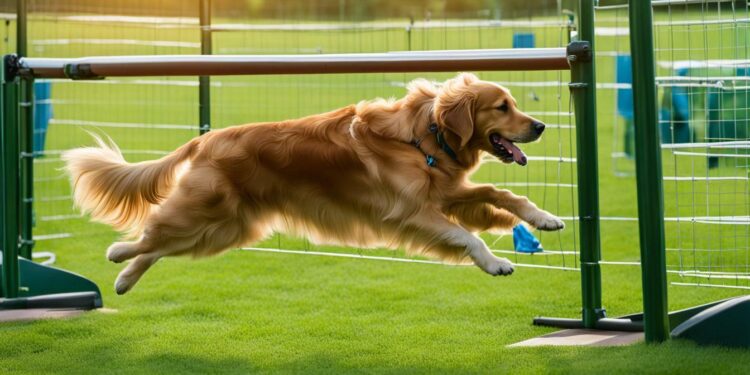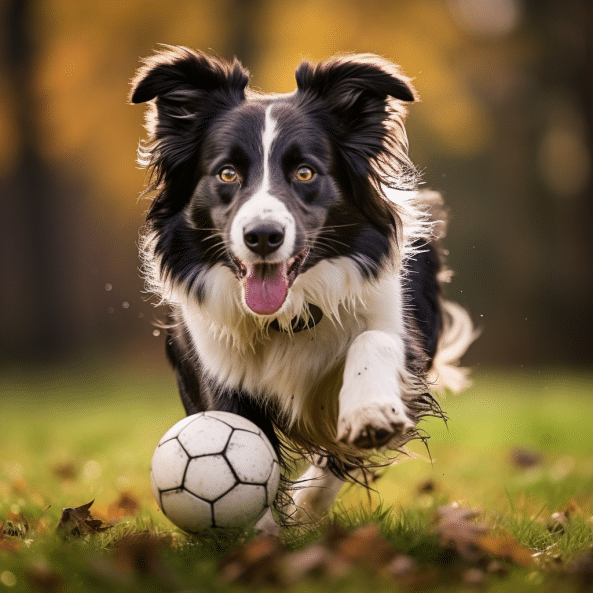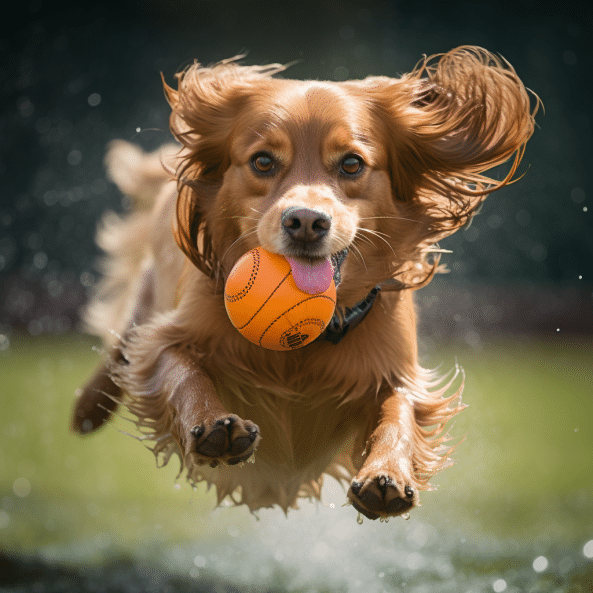Canine Sports Safety: Conditioning, Training, and Prevention

The Importance of Proper Conditioning and Training
Canine Sports Safety Tips: One of the key factors in preventing sports injuries in dogs is ensuring they receive proper conditioning and training. This section will delve into the importance of age-appropriate training and the vulnerability of puppies’ growth plates.
Just like humans, dogs require conditioning and training to prepare their bodies for physical activity and reduce the risk of injuries. However, it is essential to consider the age of the dog, as puppies have vulnerable growth plates that are sensitive to stress and impact. Age-appropriate training is crucial to avoid putting excessive strain on these developing bones and joints, which can lead to long-term damage.
Proper conditioning and training involve gradually increasing the intensity and duration of exercises to allow the dog’s body to adapt and strengthen. This helps build endurance, flexibility, and overall strength, making the dog more capable of participating in their specific sport. It is important to consult with a professional trainer or veterinarian who specializes in canine sports to develop a training plan tailored to the dog’s age, breed, and individual needs.
By investing time and effort in proper conditioning and training, dog owners can significantly reduce the risk of sports injuries. Age-appropriate training ensures the dog’s safety during their growth and development stages, while also optimizing their performance as they participate in various sports and competitions.
Warm-Up and Cool-Down Routines for Injury Prevention
Prioritizing warm-up and cool-down routines can significantly contribute to preventing sports injuries in dogs. In this section, I will discuss the benefits of incorporating these routines into your dog’s training regimen.
Warm-up routines are essential for preparing your dog’s muscles and joints for physical activity. Just like humans, dogs can benefit from gentle stretching and light aerobic exercises before engaging in more intense training or competition. A warm-up routine increases the blood flow to the muscles, improving flexibility and reducing the risk of strain or injury. It also mentally prepares your dog for the upcoming physical demands, enhancing their focus and performance.
Examples of warm-up exercises for dogs include short walks, controlled trotting, and low-impact activities like swimming or agility drills. These exercises gradually increase the heart rate and warm the muscles, preparing them for more intense physical activity. It is important to tailor the warm-up routine to your dog’s specific sport or activity, ensuring that it mimics the movements and intensity they will be performing.
Cool-down routines, on the other hand, help your dog’s body recover after training or competition. They gradually slow down the heart rate and allow the muscles to relax, reducing the risk of soreness and stiffness. Cooling down also aids in the removal of waste products, such as lactic acid, from the muscles, preventing muscle fatigue and promoting faster recovery.
Effective cool-down exercises for dogs include gentle walking and stretching. Allow your dog to gradually decrease their activity level to a comfortable pace. Perform gentle stretches, focusing on the major muscle groups, to promote flexibility and relaxation. This cooldown routine should be performed for about 5-10 minutes, depending on the intensity of the training session or competition.
| Summary: | Warm-up and cool-down routines play a crucial role in preventing sports injuries in dogs. They prepare the muscles for physical activity, reduce the risk of strain or injury, and promote faster recovery. Incorporating a warm-up routine consisting of low-impact exercises and a cool-down routine involving gentle walking and stretching can significantly contribute to your dog’s overall fitness and well-being. |
|---|
The Role of Nutrition in Preventing Injuries
A healthy diet helps dogs avoid sporting injuries. Proper nutrition, injury avoidance, and growing puppy nutrition will be discussed in this section.
Dogs need a balanced diet like people to stay healthy. Avoiding sports injuries requires much more nutritional consideration. Growing puppies need specific nutrients to support their bones, muscles, and joints. The appropriate nutrients can strengthen their bones and support healthy growth, lowering injury risk.
Protein is essential for athletic dog diet. Sports dogs need protein for muscle repair and growth. Eat high-quality animal-based proteins to get enough necessary amino acids for muscle growth and repair. Essential fatty acids like omega-3 and omega-6 reduce inflammation and improve joint health. Consuming these fats can prevent injuries and improve joint mobility.
Healthy athletic dogs should eat a range of fruits and vegetables. These vitamins, minerals, and antioxidants boost immunity, reduce oxidative stress, and improve health. Your dog’s food must be properly balanced and suited to their needs to prevent sports injuries and maintain maximum health.
| Nutrition Tips for Preventing Injuries |
|---|
| 1. Provide a balanced diet with high-quality proteins for muscle repair and growth. |
| 2. Include essential fatty acids, such as omega-3 and omega-6, to reduce inflammation and support joint health. |
| 3. Incorporate a variety of fruits and vegetables to provide essential vitamins, minerals, and antioxidants. |
| 4. Consult with a veterinarian or canine nutritionist to ensure your dog’s diet meets their specific nutritional needs. |
By paying attention to your dog’s nutrition and providing them with a well-balanced diet, you can significantly reduce the risk of sports injuries. Remember, every dog is unique, and their nutritional needs may vary depending on their age, breed, and activity level. Consulting with a veterinarian or a canine nutritionist can help you create a tailored diet plan that meets your dog’s specific needs and supports their overall health and athletic performance.
Regular Health Screenings and Injury Recognition
Preventing and treating canine sports injuries requires regular health exams and knowledge of hazards and common injuries. How regular screenings avoid injuries is explained here.
Dog owners and trainers can detect health issues or injury risks that could impair sports performance by examining dogs regularly. These checks usually include a comprehensive physical exam and diagnostic procedures such blood work, X-rays, and ultrasounds. These scans can detect early indicators of injury or strain on the dog’s body, allowing for prompt treatment.
In addition to regular checkups, dog owners and trainers must understand the hazards and typical injuries of their dog’s sport. Because agility is high-impact, agility dogs often suffer sprains, strains, and damaged ligaments. These injuries must be identified to begin treatment and prevent future damage.
Knowing the common injuries and dangers allows dog owners and trainers to adapt training methods or equipment to reduce injuries. It also helps identify injury warning signals such limping, lameness, and behavioral changes.
| Injury | Sport | Risk Factors |
|---|---|---|
| ACL Tear | Agility | High-impact movements, sudden stops and turns |
| Muscle Strain | Flyball | Explosive jumping and running, repetitive motions |
| Heat Exhaustion | Endurance Races | High temperatures, inadequate hydration |
In conclusion, regular health screenings and a comprehensive understanding of the risks and common injuries associated with canine sports play a crucial role in injury prevention and prompt treatment. By identifying potential issues before they escalate, dog owners and trainers can ensure the overall well-being and performance of their canine athletes.
Incorporating Core Body Conditioning Exercises
Core body conditioning exercises can be a valuable addition to your dog’s training routine, helping to improve balance and coordination while reducing the risk of sports injuries. In this section, I will discuss the benefits and techniques of incorporating these exercises.
One of the key benefits of core body conditioning exercises is the improvement in balance and stability. Just like in humans, a strong core in dogs can enhance their overall movement and agility. This is especially important for dogs participating in sports that require quick turns, jumps, and sudden changes in direction.
There are several exercises that can help strengthen your dog’s core. One example is the plank exercise. To perform this, have your dog lie down on their stomach and then lift their body off the ground using their forelimbs and hindlimbs, creating a straight line from their head to their tail. Hold this position for a few seconds, gradually increasing the duration as your dog gets stronger.
Sample Table
| Exercise | Description |
|---|---|
| Plank | Lie down on the stomach and lift the body off the ground, creating a straight line from head to tail. |
| Side Plank | Lie down on one side and lift the body off the ground, creating a straight line from head to tail. |
| Leg Lifts | Lie down on the back and lift the hind legs off the ground, keeping the core engaged. |
Another effective exercise for core strengthening is the side plank. Similar to the plank, this exercise involves lifting the body off the ground, but this time on one side. This targets the muscles on the side of the body and further improves balance and stability.
Leg lifts are also beneficial for targeting the core muscles. Have your dog lie down on their back and lift their hind legs off the ground while keeping their core engaged. This exercise not only strengthens the core but also helps improve overall coordination.
Incorporating core body conditioning exercises into your dog’s training routine can have numerous benefits for their overall athleticism and injury prevention. Remember to start with shorter durations and gradually increase the intensity as your dog gets stronger. Always consult with a professional trainer or veterinarian to ensure that the exercises are suitable for your dog’s fitness level and health condition.
Daily Conditioning Exercises for Injury Prevention
Preventing dog sports injuries requires daily conditioning. This section will help you teach your dog to walk, trot, and other focused movements. Regular exercise helps develop your dog’s muscles, endurance, and reduce injury risk.
Walking is one of the easiest and most effective dog workouts. At least 30 minutes of brisk walking per day, let your dog lead. This low-impact workout boosts cardio and strength. Different routes or inclines might strain your dog’s muscles even more.
You can help your dog exercise by trotting in addition to walking. Trotting enhances coordination and muscle endurance. First walk your dog at a modest pace, then gradually raise the tempo until they can trot comfortably. Before walking, keep this pace for a few minutes. Repeat this cycle several times during each workout.
Exercises that target certain muscle groups also avoid injuries. Encourage your dog to do sit-stand transitions or moderate squats. These workouts build muscle and mobility, making your dog more athletic and less likely to get hurt.
| Exercise | Description |
|---|---|
| Walking | Brisk walking for at least 30 minutes daily, varying terrain for added challenge |
| Trotting | Gradually increase speed from a walking pace to a trot, maintaining the trot for a few minutes before returning to walking |
| Targeted Movements | Encourage sit-stand transitions or gentle squats to improve strength and mobility |
Remember, consistency is key when it comes to conditioning exercises. Aim to incorporate these exercises into your dog’s routine on a daily basis to reap the full benefits. Additionally, always monitor your dog’s behavior and adjust the intensity of the exercises based on their individual abilities and fitness level.
By implementing a well-rounded exercise program, including walking, trotting, and targeted movements, you can ensure that your dog is in optimal physical condition, reducing the risk of sports injuries and promoting their overall well-being.
Age-Appropriate Conditioning for Injury Prevention
Understanding the importance of age-appropriate conditioning is crucial to prevent sports injuries in dogs. In this section, I will discuss the specific training approaches required for different age groups and the potential risks associated with insufficient conditioning.
When it comes to conditioning puppies, it is essential to be mindful of their vulnerable growth plates. These growth plates are responsible for the development and elongation of bones, and they are more prone to injury in younger dogs. It is crucial to avoid high-impact activities and excessive strain on their developing bodies. Instead, focus on gentle exercises that promote balance and coordination, such as controlled walking and trotting.
Table 1: Age-Appropriate Conditioning Guidelines
| Age Group | Training Approach |
|---|---|
| Puppies (up to 6 months) | Gentle exercises that promote balance and coordination. Avoid high-impact activities and excessive strain. |
| Adolescents (6 months to 1 year) | Gradually introduce more challenging exercises and increase the intensity and duration of physical activity. |
| Adult Dogs (1 year and above) | Maintain a consistent exercise routine that includes a mix of endurance, strength, and agility training. |
As dogs transition from puppies to adolescents, their bodies become more capable of handling increased physical activity. This is the time to gradually introduce more challenging exercises, such as jumping or weaving through obstacles, to enhance their strength and agility. However, it is still important to avoid excessive strain and provide appropriate rest periods to prevent overuse injuries.
Adult dogs require a consistent exercise routine that incorporates a mix of endurance, strength, and agility training. This helps to maintain their overall fitness and prevent muscle imbalances. Regular health screenings are also essential, as older dogs may develop age-related conditions that increase their risk of injury.
By following age-appropriate conditioning guidelines and tailoring your dog’s training regimen to their specific age group, you can significantly reduce the risk of sports injuries. Remember to consult with a veterinarian or professional dog trainer to ensure that you are providing the best possible care for your furry athlete.
The Role of Proper Training Techniques
Proper training techniques are key to preventing sports injuries in dogs and ensuring their long-term athletic success. This section will explore the importance of gradual progressions, supervised training, and avoiding excessive strain on your dog’s body.
When it comes to training your dog for sports, it’s essential to start with gradual progressions. This means gradually increasing the intensity, duration, and difficulty of the training sessions over time. Rushing the training process can lead to overexertion and potential injuries. By gradually building up your dog’s endurance and strength, you can help them develop the necessary resilience to avoid sports-related injuries.
Supervised training is another crucial aspect of injury prevention. Having a knowledgeable trainer or coach oversee your dog’s training sessions ensures that the exercises are being performed correctly, minimizing the risk of injury. They can provide valuable guidance on proper form and technique, as well as monitor your dog’s progress and make adjustments as needed.
Avoiding excessive strain on your dog’s body is vital to prevent sports injuries. Pushing your dog beyond their limits can lead to overuse injuries and long-term damage. It’s important to listen to your dog’s cues and provide them with adequate rest and recovery time. Incorporating rest days into their training schedule allows their muscles and joints to recover and reduces the risk of overexertion.
| Key Points: |
|---|
| Gradually increase training intensity and difficulty over time |
| Supervise training sessions to ensure proper technique |
| Avoid excessive strain and provide adequate rest and recovery time |
By following these proper training techniques, you can help prevent sports injuries in your dog and set them up for long-term athletic success. Remember to start slow, progress gradually, and provide necessary supervision and rest. With the right approach, you can enjoy the benefits of canine sports while keeping your furry companion safe and injury-free.
Recognizing and Treating Common Sports Injuries
Despite our best efforts, sports injuries can still occur in dogs. This section will provide you with valuable information on recognizing common sports injuries, along with appropriate first aid measures and veterinary treatments.
Injuries in dogs participating in sports can range from minor sprains and strains to more serious conditions such as fractures or ligament tears. It’s crucial to be able to recognize the signs and symptoms of these injuries to ensure prompt and appropriate treatment.
Here are some common sports injuries in dogs:
| Injury | Signs and Symptoms | Treatment |
|---|---|---|
| Strains and Sprains | Limping, swelling, pain, reluctance to put weight on the affected limb | RICE method (Rest, Ice, Compression, Elevation), pain management, physical therapy |
| Ligament Tears | Lameness, difficulty walking, swelling, pain | Surgery (in severe cases), rest, physical therapy |
| Fractures | Lameness, swelling, deformity, visible break | Emergency veterinary care, stabilization, possible surgery |
| Heat Exhaustion/Stroke | Panting excessively, weakness, collapse, excessive drooling | Cooling the dog down, providing shade and water, seeking veterinary care |
If you suspect your dog has suffered a sports injury, it is important to take immediate action. Rest the dog and restrict their movement to prevent further damage. Apply ice packs wrapped in a towel to reduce swelling and provide pain relief. However, it is crucial to seek veterinary attention for a proper diagnosis and treatment plan.
Remember, early recognition and appropriate treatment can significantly improve the chances of a full recovery for your dog. In some cases, surgery may be necessary for more severe injuries. Rehabilitation and physical therapy may also be recommended to aid in the recovery process and help your dog regain strength and mobility.
Building Resilience and Preventing Overuse Injuries
Building resilience and preventing overuse injuries are critical aspects of canine sports injury prevention. In this section, I will share valuable insights on managing training intensity, incorporating rest days, and recognizing signs of fatigue or stress in your dog.
To ensure your dog’s well-being and reduce the risk of overuse injuries, it’s important to carefully manage their training intensity. Gradually increase the intensity and duration of their workouts to allow their muscles, tendons, and ligaments to adapt and strengthen over time. Pushing them too hard too soon can lead to injuries such as strains, sprains, or even stress fractures. Remember, a gradual progression is key to building their endurance and preventing overuse injuries.
Incorporating regular rest days into your dog’s training schedule is also crucial. Just like humans, dogs need time to recover and recharge. Rest days help prevent fatigue and reduce the risk of overuse injuries. Use these days for gentle activities, such as leisurely walks or mentally stimulating games, to keep your dog engaged without putting excessive strain on their body.
Recognizing signs of fatigue or stress in your dog is essential for injury prevention. Watch for decreased performance, reluctance to participate in activities, excessive panting, or changes in behavior. These signs may indicate that your dog is experiencing physical or mental fatigue. If you notice any of these signs, it’s important to give them rest and consult with a veterinarian if necessary. Monitoring your dog’s well-being and making adjustments to their training regimen accordingly can help prevent overuse injuries and ensure their long-term athletic success.
| Managing Training Intensity: | Gradually increase the intensity and duration of workouts. |
|---|---|
| Incorporating Rest Days: | Allow your dog time to recover and recharge. |
| Recognizing Signs of Fatigue: | Watch for decreased performance, reluctance to participate, excessive panting, or changes in behavior. |
The Importance of Recovery and Rehabilitation
Ensuring proper recovery and rehabilitation is essential for dogs to overcome sports injuries. In this section, I will discuss the importance of rest, therapy, and other techniques to aid in your dog’s healing and return to full athleticism.
Rest plays a crucial role in the recovery process after a sports injury. It allows the dog’s body to repair damaged tissues and reduce inflammation. During this time, it’s essential to limit physical activity and provide a calm and comfortable environment for your dog to heal.
Therapy is another key component of the recovery process. Physical therapy exercises, such as range-of-motion movements and therapeutic exercises, can help improve joint flexibility, muscle strength, and overall mobility. Hydrotherapy, which involves swimming or walking on an underwater treadmill, is particularly beneficial as the water provides resistance while reducing stress on the joints.
Quote:
“Proper recovery and rehabilitation are crucial for dogs to regain their strength and return to their full potential after a sports injury.” – Dr. Sarah Johnson, Canine Sports Medicine Specialist
In addition to rest and therapy, other techniques can aid in your dog’s healing. These include massage therapy, acupuncture, and cold and heat therapy. Massage therapy helps improve blood circulation, reduces muscle tension, and promotes relaxation. Acupuncture can help alleviate pain and stimulate the body’s natural healing processes. Cold therapy, such as applying ice packs to the affected area, can reduce swelling, while heat therapy, such as warm compresses, can improve blood flow and promote healing.
It’s important to note that recovery and rehabilitation should be tailored to the specific injuries and needs of your dog. Consulting with a veterinary professional who specializes in canine sports medicine can provide valuable guidance on the most appropriate techniques and therapies for your dog’s recovery journey.
| Recovery and Rehabilitation Techniques | Benefits |
|---|---|
| Rest | – Allows the body to repair damaged tissues – Reduces inflammation |
| Physical therapy | – Improves joint flexibility and muscle strength – Enhances overall mobility |
| Hydrotherapy | – Provides resistance without stressing the joints – Aids in muscle recovery and cardiovascular fitness |
| Massage therapy | – Improves blood circulation and muscle relaxation – Reduces muscle tension |
| Acupuncture | – Alleviates pain and stimulates natural healing – Enhances overall well-being |
| Cold and heat therapy | – Reduces swelling and inflammation – Promotes blood flow and healing |
Conclusion
Finally, adequate conditioning, nutrition, training, and injury recognition are needed to avoid and heal canine sports injuries. These tips can keep your athletic dog healthy and happy.
Preventing dog sports injuries requires proper conditioning and training. Due to puppies’ fragile development plates, age-appropriate training is essential. Warm-up, cool-down, and endurance and strength exercises prepare the dog’s muscles for physical activity and reduce injury risk.
Growing puppies need good nutrition to avoid injuries. A balanced diet improves health and prevents injuries. Regular health checks and knowledge of sport-specific dangers and injuries are essential for early detection and treatment.
Pilates-style core body fitness workouts can improve dogs’ balance, coordination, and strength, minimizing sports injury risk. Daily conditioning exercises including walking, trotting, and particular movements assist in canine fitness and injury prevention.
Sports injuries can be reduced by using good training methods, gradually developing, and avoiding overstraining the dog. A complete recovery requires recognizing common injuries and administering first aid and veterinary care.
Management of training intensity, rest days, and fatigue or stress signals help build resilience and prevent overuse injuries. Finally, proper recovery and rehabilitation help dogs heal and return to sports.
You can protect your athletic dog by taking a holistic approach to sports injury prevention and recovery. A healthy, happy dog can enjoy their favorite sports and activities more.
FAQ
Q: What are some common sports injuries in dogs?
A: Common sports injuries in dogs include ligament tears, muscle strains, joint sprains, and stress fractures.
Q: How can proper conditioning and training help prevent canine sports injuries?
A: Proper conditioning and training help strengthen the dog’s muscles, improve flexibility, and reduce the risk of injury during physical activity.
Q: Why is age-appropriate training important in preventing sports injuries in puppies?
A: Puppies have vulnerable growth plates that are prone to injury, so age-appropriate training ensures their safety and avoids long-term damage.
Q: What are warm-up and cool-down routines, and why are they important?
A: Warm-up routines involve light exercises and stretches to prepare the dog’s muscles for physical activity, while cool-down routines help prevent muscle stiffness and soreness after exercise.
Q: How does nutrition play a role in preventing sports injuries in dogs?
A: A balanced diet provides essential nutrients for bone health, muscle strength, and overall wellness, which helps prevent injuries, especially in growing puppies.
Q: What are some common signs of sports injuries in dogs?
A: Signs of sports injuries in dogs may include limping, swelling, pain or discomfort, difficulty moving, and decreased activity or performance levels.
Q: How can I incorporate core body conditioning exercises into my dog’s routine?
A: Core body conditioning exercises, such as balancing on unstable surfaces or performing specific movements, can be incorporated into your dog’s routine with the help of a professional trainer or under their guidance.
Q: What are some daily conditioning exercises that can help prevent sports injuries?
A: Daily conditioning exercises may include regular walking, trotting, and incorporating specific movements or agility exercises that mimic the demands of the dog’s sport.
Q: How can I recognize and treat common sports injuries in my dog?
A: If you notice signs of injury, such as limping or swelling, it’s important to consult a veterinarian for a proper diagnosis and treatment plan. Treatment may include rest, pain management, rehabilitation exercises, or, in severe cases, surgery.
Q: What should I do if my dog sustains a sports injury?
A: If your dog sustains a sports injury, it’s important to seek veterinary care immediately. In the meantime, you can apply a cold compress, restrict their activity, and keep them comfortable.
Q: How can I prevent overuse injuries in my athletic dog?
A: To prevent overuse injuries, it’s important to manage training intensity, incorporate rest days, monitor signs of fatigue or stress, and gradually increase the dog’s fitness level over time.








